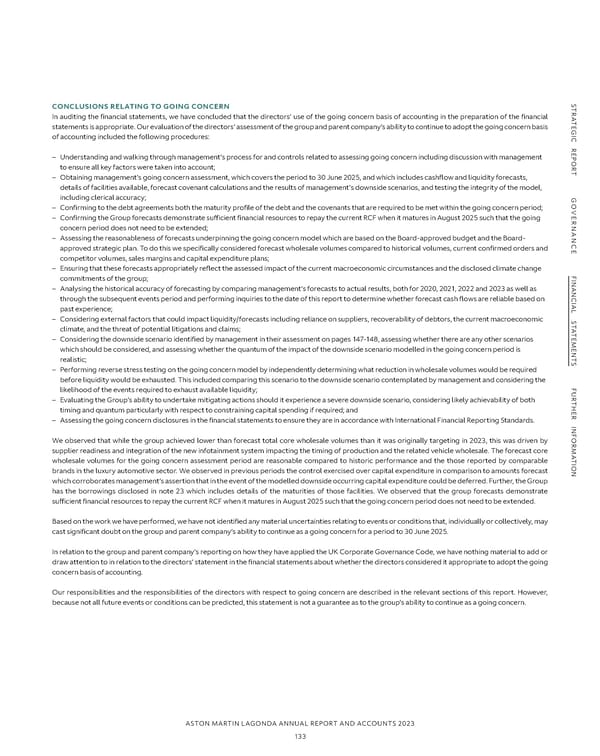S S TR CONCLUSIONS RELATING TO GOING CONCERN TR A In auditing the financial statements, we have concluded that the directors’ use of the going concern basis of accounting in the preparation of the financial A TE statements is appropriate. Our evaluation of the directors’ assessment of the group and parent company’s ability to continue to adopt the going concern basis TE G G I I C of accounting included the following procedures: C R R E E P – Understanding and walking through management’s process for and controls related to assessing going concern including discussion with management P O O R to ensure all key factors were taken into account; R T – Obtaining management’s going concern assessment, which covers the period to 30 June 2025, and which includes cashflow and liquidity forecasts, T details of facilities available, forecast covenant calculations and the results of management’s downside scenarios, and testing the integrity of the model, G including clerical accuracy; G O – Confirming to the debt agreements both the maturity profile of the debt and the covenants that are required to be met within the going concern period; O VE – Confirming the Group forecasts demonstrate sufÏcient financial resources to repay the current RCF when it matures in August 2025 such that the going VE R R NAN concern period does not need to be extended; NAN – Assessing the reasonableness of forecasts underpinning the going concern model which are based on the Board-approved budget and the Board- C C E approved strategic plan. To do this we specifically considered forecast wholesale volumes compared to historical volumes, current confirmed orders and E competitor volumes, sales margins and capital expenditure plans; – Ensuring that these forecasts appropriately reflect the assessed impact of the current macroeconomic circumstances and the disclosed climate change F F I commitments of the group; I NAN – Analysing the historical accuracy of forecasting by comparing management’s forecasts to actual results, both for 2020, 2021, 2022 and 2023 as well as NAN C through the subsequent events period and performing inquiries to the date of this report to determine whether forecast cash flows are reliable based on C IAL IAL past experience; S – Considering external factors that could impact liquidity/forecasts including reliance on suppliers, recoverability of debtors, the current macroeconomic S T T A climate, and the threat of potential litigations and claims; A T T E – Considering the downside scenario identified by management in their assessment on pages 147-148, assessing whether there are any other scenarios E M M E which should be considered, and assessing whether the quantum of the impact of the downside scenario modelled in the going concern period is E N N T realistic; T S – Performing reverse stress testing on the going concern model by independently determining what reduction in wholesale volumes would be required S before liquidity would be exhausted. This included comparing this scenario to the downside scenario contemplated by management and considering the F F U likelihood of the events required to exhaust available liquidity; U R R T – Evaluating the Group’s ability to undertake mitigating actions should it experience a severe downside scenario, considering likely achievability of both T H H E timing and quantum particularly with respect to constraining capital spending if required; and E R R INF – Assessing the going concern disclosures in the financial statements to ensure they are in accordance with International Financial Reporting Standards. INF OR We observed that while the group achieved lower than forecast total core wholesale volumes than it was originally targeting in 2023, this was driven by OR M supplier readiness and integration of the new infotainment system impacting the timing of production and the related vehicle wholesale. The forecast core M A A T wholesale volumes for the going concern assessment period are reasonable compared to historic performance and the those reported by comparable T I I ON brands in the luxury automotive sector. We observed in previous periods the control exercised over capital expenditure in comparison to amounts forecast ON which corroborates management’s assertion that in the event of the modelled downside occurring capital expenditure could be deferred. Further, the Group has the borrowings disclosed in note 23 which includes details of the maturities of those facilities. We observed that the group forecasts demonstrate sufÏcient financial resources to repay the current RCF when it matures in August 2025 such that the going concern period does not need to be extended. Based on the work we have performed, we have not identified any material uncertainties relating to events or conditions that, individually or collectively, may cast significant doubt on the group and parent company’s ability to continue as a going concern for a period to 30 June 2025. In relation to the group and parent company’s reporting on how they have applied the UK Corporate Governance Code, we have nothing material to add or draw attention to in relation to the directors’ statement in the financial statements about whether the directors considered it appropriate to adopt the going concern basis of accounting. Our responsibilities and the responsibilities of the directors with respect to going concern are described in the relevant sections of this report. However, because not all future events or conditions can be predicted, this statement is not a guarantee as to the group’s ability to continue as a going concern. ASTON MARTIN LAGONDA ANNUAL REPORT AND ACCOUNTS 2023 133
 Annual Report and Accounts Page 134 Page 136
Annual Report and Accounts Page 134 Page 136